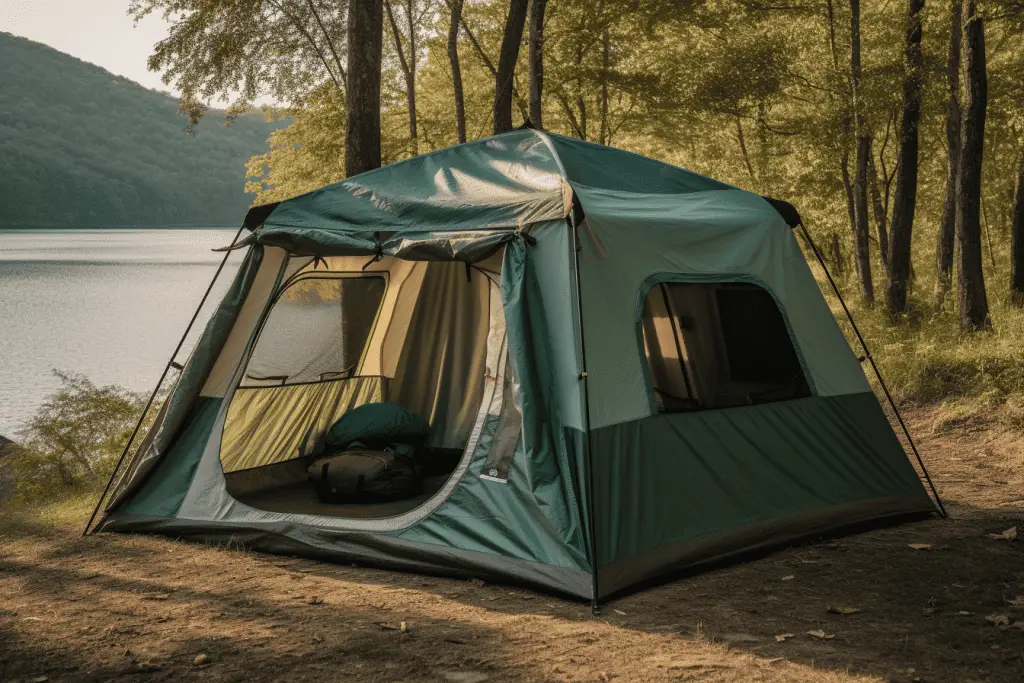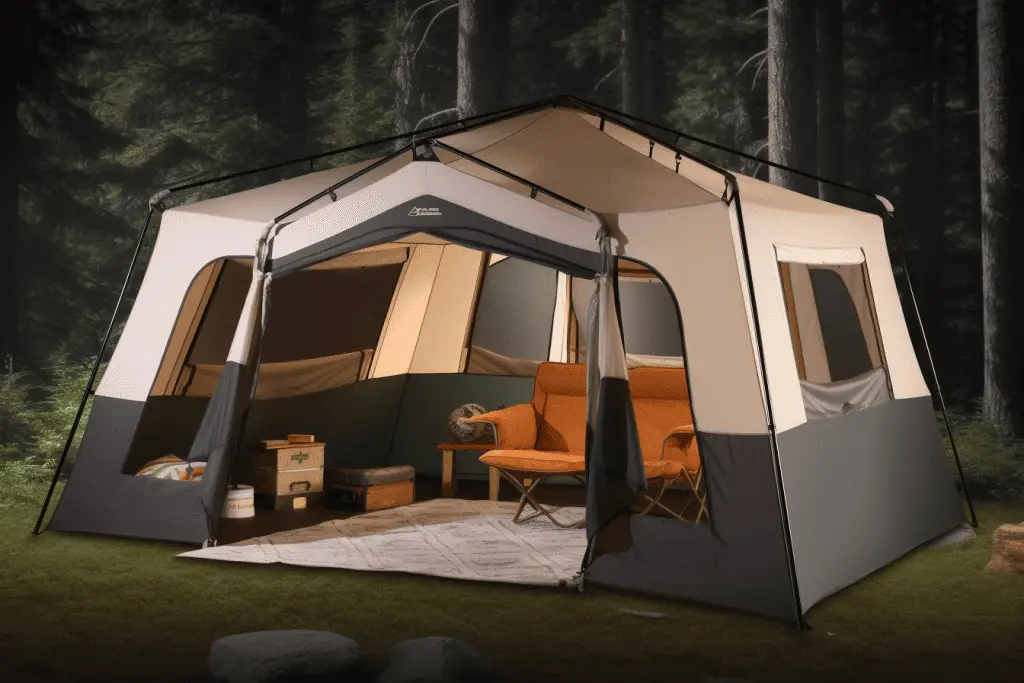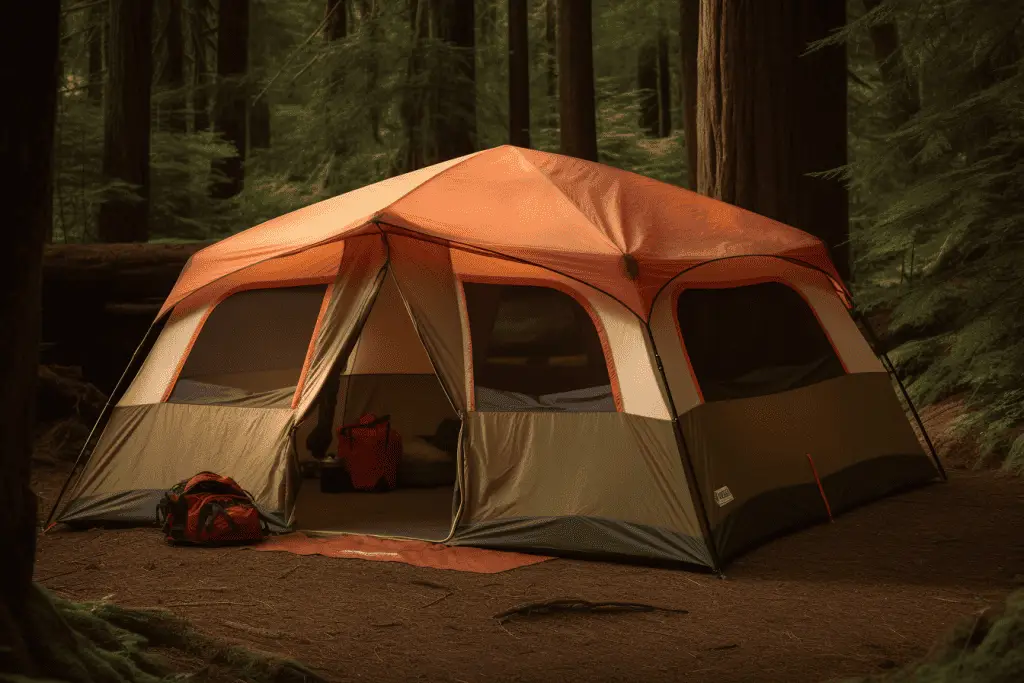There are so many different types of tents for camping to choose from that it can be difficult to keep up. We’re here to help. In this post, we’ll get you updated on the cabin tent. So, what is a cabin tent?
A cabin tent is a type of tent that is designed to resemble a cabin or small house. It typically has vertical walls and a peaked roof, providing more headroom and space compared to traditional dome tents. Cabin tents are often larger and more spacious, making them suitable for families or groups of people who want more comfort and room while camping.

The Advantages and Disadvantages of Cabin Tents
Firstly, let’s talk about the good stuff – the advantages of cabin tents. One of the main perks of a cabin tent is the space it provides. With their near-vertical walls and high ceilings, cabin tents allow you to move around inside with ease, making them perfect for larger groups or families. And if you’re the type of camper who likes to bring along plenty of gear, the extra room is a definite plus. Some models even offer room dividers, creating a sense of privacy, much like a mini mobile home! Plus, these tents usually come with large windows, providing excellent ventilation and a great view of your outdoor surroundings.
Now, every silver lining has a cloud. The size and structure of cabin tents also mean they can be quite heavy. If you’re a backpacker or if you need to trek a distance to your camping site, this might not be the best option. Setup can also be a bit more complex compared to smaller, simpler tent styles. Lastly, while they’re great in calm weather, cabin tents can struggle in heavy winds due to their high profile and flat sides.
In a nutshell, cabin tents are your go-to if you prioritize space, comfort, and the feeling of a ‘home away from home’ on your camping trips. But if you’re a lone wanderer, frequently on the move or camping in windy conditions, you might want to explore other options. It’s all about finding the right balance for your needs.
Here is a quick table that shows the pros and cons of cabin tents.
| Pros | Cons |
|---|---|
| Spacious with high ceilings for easier movement and comfort. | Tend to be heavy, not ideal for backpacking or long treks to the campsite. |
| Home-like feel with vertical walls and room dividers for more privacy. | Can be more complex to set up compared to smaller, simpler tents. |
| Large windows provide excellent ventilation and great views. | High profile and flat sides can make them less stable in heavy winds. |
Ideal Use Cases for Cabin Tents: Who Should Buy Them?
First and foremost, if you’re planning a camping trip with your family or a large group of friends, a cabin tent can be an excellent choice. The spacious interiors are perfect for accommodating more people comfortably, and some models come with room dividers, making it easier to create separate “rooms” for sleeping, changing, or storing gear. It’s like bringing a little piece of home with you into the wilderness.
Now, if you’re someone who values comfort over minimalism when you’re camping, a cabin tent is right up your alley. With their high ceilings, you’ll be able to stand up straight instead of crouching down. Plus, the large windows allow for plenty of ventilation and light, enhancing the overall camping experience.

Last but not least, cabin tents are a fantastic pick for those who enjoy glamping – a blend of glamour and camping. Whether you’re at a music festival or just prefer a luxurious camping experience, the homely vibe and room for extra amenities like camping furniture make cabin tents a top-notch choice.
However, if you’re a solo traveler, an ultralight backpacker, or someone who moves camp frequently, you might want to consider a different style of tent that’s lighter and easier to pitch. Remember, the best tent is the one that fits your specific needs and camping style.
Factors to Consider When Buying a Cabin Tent
One of the first things to consider is size. How many people will be sleeping in the tent? Do you need room for gear or a pet? Remember, while a tent might be marketed as a “6-person tent,” that doesn’t always account for extra space you might want for comfort. When in doubt, it’s usually a good idea to size up.
Next, think about the weight. If you’re car camping and only have to carry the tent from your trunk to the campsite, a heavier, larger tent might be fine. But, if you’re hiking in, you’ll want to find a balance between size and weight.
Durability is another important factor. Look for a tent made from high-quality materials with a solid build. While these might cost more upfront, they’re likely to last longer, saving you money in the long run.
The tent’s setup process is also something to consider. If you’re a camping newbie, you might want a tent that’s easy to pitch. Or, if you’re an experienced camper, maybe you’re okay with a more complex setup in exchange for other features.
Weather resistance should be on your radar too. Some cabin tents come with a rainfly or a full-coverage canopy that can help protect you from rain or dew. Also, consider how well-ventilated the tent is, particularly if you plan to camp in warmer climates.
Lastly, think about extra features that could enhance your camping experience. Things like room dividers, internal storage pockets, e-ports for electrical cords, or a vestibule for gear storage could come in handy.
Remember, the perfect cabin tent for you will depend on your individual camping style and needs. Consider these factors and you’re sure to find a tent that’ll serve you well on your adventures!
Practical Tips for Setting Up a Cabin Tent
Here are some practical tips to help you set up a cabin tent:
- Choose the Right Spot: Find a flat, clear area to set up your tent. Avoid locations with sharp rocks or roots that could puncture the tent’s floor. If possible, try to set up your tent at a higher elevation to avoid water pooling during rain.
- Lay Down a Footprint: A footprint is a protective layer that goes underneath your tent to protect it from the ground. It can help prevent wear and tear and extend the life of your tent.
- Unpack and Organize: Once you’ve chosen your spot, unpack the tent and separate all components (poles, stakes, rainfly, etc.). This helps in the easy identification of parts when setting up.
- Assemble the Frame: Cabin tents usually come with a lot of poles to support their structure. Identify each one (they may be color-coded or numbered) and assemble them according to the tent’s instructions.
- Raise the Tent: Start by attaching one corner of the tent to a pole and work your way around, attaching the rest of the tent to the frame. This often requires more than one person, so be sure to have a helping hand.
- Secure the Tent: Once the structure is up, secure it with stakes at each corner and at other designated points. Make sure to pull the tent floor taut to prevent tripping hazards and to ensure the tent structure is sound.
- Attach the Rainfly: If your cabin tent comes with a rainfly, attach it over the frame. This will provide added protection against rain and wind.
- Final Check: Walk around the tent to make sure everything is secure. Double-check the stakes and ensure the zippers work properly.
Setting up a cabin tent can be a bit of a task, especially the first few times. It helps to do a practice run at home before you head out to the great outdoors. Remember, patience and teamwork make the process much easier!
Customizing Your Cabin Tent: Accessories and Enhancements
One of the best things about cabin tents is their size, which gives you a lot of room to play around with. So, why not make it feel a little more like home? Adding a camping rug can make the space cozier and warmer underfoot, particularly on chilly mornings.
Next, think about your sleeping arrangements. If you want a bit more comfort than a sleeping bag on the ground, consider bringing in some air mattresses or camping cots. Not only can these make sleeping more comfortable, but they can also help you make use of the vertical space in your cabin tent.
Lighting is another aspect where you can really get creative. Solar lanterns or battery-powered LED lights can create a warm and welcoming ambiance after dark. You can hang them from the top of the tent, or even string up some fairy lights for a truly magical camping experience.

Storage is another area you might want to consider. Portable shelves or hanging organizers can help keep your belongings tidy and easy to find. Similarly, a shoe mat placed at the entrance can keep dirt from trekking into your living space.
One more thing – don’t forget about the outside of your tent! A camping awning or sunshade can extend your living area, providing a great place to relax in the shade during the day.
Remember, customizing your cabin tent is all about enhancing comfort and convenience while expressing your personal style. So, have fun with it and create a camping environment that feels just right for you!
Essential Maintenance Tips for Cabin Tents
First things first, always keep your tent clean. After each trip, give it a good shake to get rid of any dirt, leaves, or bugs that may have snuck in. If you spot any stains, gently clean them with a mild soap and water solution. Remember, harsh detergents can damage the fabric and protective coatings of the tent.
Next up, let’s talk about storage. It’s crucial to make sure your tent is completely dry before you pack it away. Storing a wet or damp tent can lead to mold and mildew, which are not only smelly but can also degrade the material of your tent. If you have to pack up your tent while it’s still wet, be sure to dry it out as soon as you can when you get home.
Thirdly, proper handling can significantly increase your tent’s lifespan. Be gentle when setting up and taking down your tent. Avoid dragging it across the ground, and when packing, roll or neatly fold the tent rather than stuffing it in its storage bag.
Lastly, take care of any repairs promptly. If you notice a small tear or if a zipper isn’t working correctly, address the issue as soon as possible to prevent it from getting worse. Most tent manufacturers sell repair kits that can handle minor damage. For significant repairs, you might need professional help.
All in all, taking care of a cabin tent doesn’t require a ton of work. It’s mostly about regular cleaning, proper storage, gentle handling, and prompt repairs.
Conclusion: Choosing the Right Cabin Tent for Your Outdoor Adventures
Cabin tents can truly revolutionize the way you experience the outdoors, offering an enticing mix of comfort, space, and convenience. Whether you’re planning a family camping trip, a fun-filled outdoor adventure with friends, or a luxurious glamping experience, these tents provide a ‘home away from home’ feeling that makes any camping trip a joy. With numerous features and options to customize, a cabin tent can cater to a variety of needs, and be a valuable companion on your outdoor escapades.
However, like any investment, it’s essential to choose wisely. Carefully consider factors like size, weight, durability, ease of setup, weather resistance, and added features when purchasing a cabin tent. Be sure to handle your tent with care, maintain it well, and it can serve you for many camping seasons to come. Ultimately, the perfect cabin tent will depend on your individual needs and camping style, so take your time to find the one that fits just right for you.
